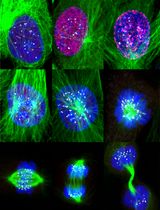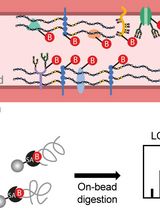- EN - English
- CN - 中文
High Throughput Blood-brain Barrier Organoid Generation and Assessment of Receptor-Mediated Antibody Transcytosis
高通量血脑屏障类器官的产生和受体介导的抗体转胞吞作用的评估
(*contributed equally to this work) 发布: 2022年04月20日第12卷第8期 DOI: 10.21769/BioProtoc.4399 浏览次数: 4348
评审: Pilar Villacampa AlcubierreWilliam C. W. ChenAnand Ramesh Patwardhan
Abstract
Targeting receptor-mediated transcytosis (RMT) is a successful strategy for drug delivery of biologic agents across the blood-brain barrier (BBB). The recent development of human BBB organoid models is a major advancement to help characterize the mechanisms of RMT and thus accelerate the design of brain delivery technologies. BBB organoids exhibit self-organization, which resembles the architecture of the neurovascular unit, and low paracellular permeability, due to the formation of tight junctions between endothelial cells. However, current methods of organoid generation have low throughput, exhibit substantial heterogeneity across experiments, and require extensive manual handling. These limitations prevent the use of BBB organoids as a screening tool for discovery and optimization of therapeutic molecules. In this protocol, we use hydrogel-based arrays to generate human BBB organoids, with a 35-fold increase in organoid yield as compared to previous protocols using 96-well plates. We incubate BBB organoid arrays with monoclonal antibody-based constructs and use a custom semi-automated imaging assay to assess RMT within the organoid core. The experimental and analytical tools described in this protocol provide a scalable platform that can be incorporated in the early stages of drug discovery to accelerate the development and optimization of brain delivery technologies to cross the BBB.
Keywords: Blood-brain barrier (血脑屏障)Background
The blood-brain barrier (BBB) is a highly selective biological interface composed of brain endothelial cells, pericytes, and astrocytes, that tightly regulates the transport of molecules from the blood into the brain parenchyma. Brain delivery of therapeutic proteins is hindered by their low rate of transport across the BBB. A clinically-validated approach to increase transport across the BBB is to target endogenous receptors expressed on brain microvascular endothelial cells with protein shuttles. The development of such protein shuttle platforms requires scalable in vitro systems that allow high-throughput screening for both compound optimization and systematic discovery of transport mechanisms.
Previously described in vitro systems to investigate transcytosis across the BBB include transwell models, microfluidic systems, or organoids. Previous work showed that organoids are superior to transwell models for recapitulating angiopep-2 transcytosis (Cho et al., 2017). The direct cell-cell interaction in BBB organoid arrays also increases the expression of receptors involved in transcytosis compared to cells in transwells (Urich et al., 2013). On the other hand, microfluidic systems recapitulate complex vascular networks and can generate quantitative permeability data (Hajal et al., 2022). However, this type of models is not yet scalable for high-throughput screening.
Different groups described the generation of BBB organoids by the self-assembly of human brain endothelial cells, astrocytes, and pericytes (Urich et al., 2013; Cho et al., 2017; Nzou et al., 2018). Importantly, BBB organoids recapitulated key functional properties of the BBB, including tight junction formation, expression of efflux transporters, and low permeability to macromolecules. However, previous protocols require extensive manual handling, and exhibit high inter-experimental variability that prevent their widespread adoption for high-throughput screening. This protocol solves these limitations by: 1) increasing organoid generation yield by 35-fold, 2) enabling the growth of homogeneous organoids in a 96-well format, 3) developing a simple microscopy-based assay to assess transport across the BBB, and 4) automating image analysis. The focus of this protocol is on evaluating receptor-mediated transcytosis of antibodies. However, it can be modified to evaluate transport of other biologic agents, including peptides, nanoparticles, and viruses. Since the main readout is microscopy-based, users can combine it with viability probes to evaluate acute cytotoxic effects in endothelial cells, astrocytes, or pericytes. Overall, these characteristics make BBB organoid arrays a flexible assay platform for screening applications in a drug discovery setting.
Materials and Reagents
50 mL polypropylene conical tube (Falcon, catalog number: 352070)
Tissue culture flask, 250 mL, 75 cm2 (Falcon, catalog number: 353136)
GRI3D 96-well plate (VWR, catalog number: MSPPGRI3D-96P-S, order plates with a well diameter of 600 µm), store at 4°C
Eppendorf tubes 5.0 mL with snap cap, 5.0 mL, sterile, colorless (Eppendorf, catalog number: 0030119487)
Eppendorf Safe-Lock tubes, 1.5 mL (Eppendorf, catalog number: 0030121589)
Eppendorf Protein LoBind Tube 1.5 mL (Eppendorf, catalog number: 022431081)
Countess cell counting chamber slide (Invitrogen, catalog number: C10228)
Adhesive microscope slides for tissue sections, ground edges, twin frosted end (Marienfeld Superior, catalog number: 0800001)
High Precision Microscope cover glasses 22 × 22 mm No 1.5H (Marienfeld Superior, catalog number: 0107052)
Blood-brain barrier hCMEC/D3 endothelial cell line (Millipore Sigma, catalog number: SCC066)
Human Astrocytes (ScienCell, catalog number: 1800)
Human Brain Vascular Pericytes (ScienCell, catalog number: 1200)
Endothelial Media: EGM-2 Endothelial Cell Growth Medium-2 BulletKit (Lonza, catalog number: CC-3156), store at 4°C, do not use for longer than 1 month
Astrocyte Media (ScienCell, catalog number: 1801), store at 4°C, do not use for longer than 1 month
Pericyte Media (ScienCell, catalog number: 1201), store at 4°C, do not use for longer than 1 month
Organoid Media: EGM-2 Endothelial Cell Growth Medium-2 BulletKit (Lonza, catalog number: CC-3156) without VEGF, store at 4°C, do not use for longer than 1 month
Trypsin 0.05% (Gibco, catalog number: 25300-054), store at 4°C after initial thaw from -20°C
Dulbecco’s Phosphate Buffered Saline (DPBS) (Gibco, catalog number: 14190-094), store at room temperature
Poly-L-Lysine (PLL) solution, mol wt 150,000–300,000, 0.01% sterile filtered (Sigma, catalog number: P4832-50ml), store at 4°C
Ultrapure Distilled Water DNase/RNase Free (UPW; Invitrogen, catalog number: 10977-035), store at room temperature
Eppendorf Protein LoBind 0.5 mL (Eppendorf, catalog number: 022431064)
Trypan blue stain 0.4% (Invitrogen, catalog number: T10282), store at room temperature
Brain Shuttle – custom-made anti-transferrin receptor antibody (Sade et al., 2013). Store at -80°C. This molecule can be replaced by any other anti-transferrin receptor antibody, for example MEM-189 (Abcam, catalog number: ab1086).
CellEventTM Caspase-3/7 Green Detection Reagent (Thermo Fisher Scientific, catalog number: C10423), store at -20°C
16% Paraformaldehyde Aqueous Solution EM Grade (PFA) (Electron Microscopy Sciences, catalog number: 50-980-487), store at room temperature
Triton X-100 aqueous solution 10% (w/v) (Roche, catalog number: 11332481001), store at 4°C
Donkey Serum sterile filtered (Canvax Biotech, catalog number: SUD004), store at -20°C
Human IgG (H+L) AlexaFluor 488-coupled goat AffiniPure Fab Fragment (Jackson Immunoresearch, catalog number: 109-547-003), resuspend with glycerol and dH2O as per the supplier’s instructions, and store at -20°C.
DAPI (Sigma, catalog number: D9542-5mg), store at 4°C
Disposable wipes KIMTECH® Science precision wipes, 7552 (Carl Roth, catalog number: AA64.1)
Fluoromount-G (Electron Microscopy Sciences, catalog number: 17984-25)
Leica Microsystems Type F Immersion Oil for Microscopes (Fisher Scientific, catalog number: 11944399)
Poly-L-Lysine solution (see Recipes)
4% PFA solution (see Recipes)
Permeabilization Buffer (see Recipes)
Dilution Buffer (see Recipes)
Wash Buffer (see Recipes)
Equipment
Thermo Scientific Precision Water Bath GP 15-D 5L and 10L (Dual) (Thermo Scientific, catalog number: TSGP15D)
CountessTM II FL automated cell counter (Thermo Fisher Scientific, Invitrogen, catalog number: AMQAF1000)
Centrifuge 5804R (Eppendorf, catalog number: 5804000520)
Zeiss Axio Observer 3 LED or DMi8 Leica widefield microscope
VWR Rotator Multimix 230V Swis (VWR Collection, catalog number: 444-0501)
Curved and sharp tweezers (VWR, catalog number: 232-0078)
Scanning laser confocal microscope (Leica, model: SP5)
Software
ImageJ/Fiji software versions 1.53n (available for download: https://imagej.net/)
Procedure
文章信息
版权信息
© 2022 The Authors; exclusive licensee Bio-protocol LLC.
如何引用
Kassianidou, E., Simonneau, C., Gavrilov, A. and Villaseñor, R. (2022). High Throughput Blood-brain Barrier Organoid Generation and Assessment of Receptor-Mediated Antibody Transcytosis. Bio-protocol 12(8): e4399. DOI: 10.21769/BioProtoc.4399.
分类
神经科学 > 基础技术 > 高通量筛选
神经科学 > 神经系统疾病 > 血脑屏障
细胞生物学 > 细胞成像 > 固定细胞成像
您对这篇实验方法有问题吗?
在此处发布您的问题,我们将邀请本文作者来回答。同时,我们会将您的问题发布到Bio-protocol Exchange,以便寻求社区成员的帮助。
提问指南
+ 问题描述
写下详细的问题描述,包括所有有助于他人回答您问题的信息(例如实验过程、条件和相关图像等)。
Share
Bluesky
X
Copy link












